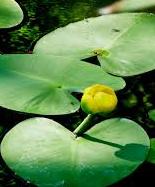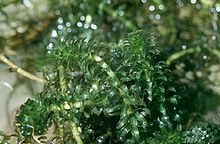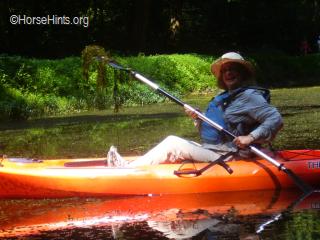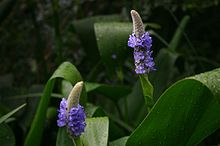On our kayaking adventures we encounter all types of vegetation that can interfere with efficient paddling. Below are some examples of what we have encountered and been able to identify:
Spatterdock

Spatterdock: May be confused with European frogbit, yellow floating heart, small and large yellow pond lilies, little floating heart, watershield, and fragrant water lily.
Bill and I have encountered spatterdock, aka cow lily, while kayaking this spring and summer. It is a perennial, part of the floating-leaved plant community, and looks much like a water lily as well as the other look alikes mentioned under the image. It rises from a large rhizonme. The flowers are yellow and appear to be half opened. The leaves are slit making them appear heart shaped. The plant is often seen floating and the heart shaped leaves are on stems may be 6' long. Much of the plant is also submerged. They make a fruit that is in an oval shape with a flat top. It is usually a greenish or yellowish color. We have seen it in the C&O Canal, some of the lakes and slow moving streams.
Hydrilla

Hydrilla is often confused with the native ![]() Elodea
Elodea ![]() (Elodea is a genus of aquatic plants often called the waterweeds. Elodea is native to North America and is also widely used as aquarium vegetation. It lives in freshwater.) or the non-native
(Elodea is a genus of aquatic plants often called the waterweeds. Elodea is native to North America and is also widely used as aquarium vegetation. It lives in freshwater.) or the non-native ![]() Egeria.
Egeria. ![]() (In the United States Egeria occurs from New York south to Florida and west to California and Oregon. In the Sacramento-San Joaquin Delta of California, it was introduced in the 1960s and has since had a significant adverse impact on the local ecosystem.)
(In the United States Egeria occurs from New York south to Florida and west to California and Oregon. In the Sacramento-San Joaquin Delta of California, it was introduced in the 1960s and has since had a significant adverse impact on the local ecosystem.)
 A perennial plant, hydrilla, forms dense colonies and can grow to the surface in water over 20 feet deep. Hydrilla is profuse and after reaching the surface it extends across it forming thick mats. Although native to Europe and Asia, it is thought to been brought to the U.S. for the aquarium industry. It grows rapidly and is considered a noxious pest. It kills inactive aquatic plants that cannot compete with its prolific nature. Bill and I have tried to kayak through thick mats of this stuff which makes paddling and navigation almost impossible.
A perennial plant, hydrilla, forms dense colonies and can grow to the surface in water over 20 feet deep. Hydrilla is profuse and after reaching the surface it extends across it forming thick mats. Although native to Europe and Asia, it is thought to been brought to the U.S. for the aquarium industry. It grows rapidly and is considered a noxious pest. It kills inactive aquatic plants that cannot compete with its prolific nature. Bill and I have tried to kayak through thick mats of this stuff which makes paddling and navigation almost impossible.
One could say that it has one virtue like most aquatic species and that is it provides a habitat for micro and macro invertebrates. These invertebrates provide fish and other wildlife. However, hydrilla barely does that. Hydrilla turions and tubers are consumed by some ducks and grass carp, but generally it is not considered a good wildlife food.
"Hydrilla is naturalised and invasive in the United States following release in the 1960s from aquariums into waterways in Florida. It is now established in Canada and the southeast from Connecticut to Texas, and also in California. By the 1990s control and management were costing millions of dollars each year. Hydrilla can be herbicides and it is also eaten by grass carp, itself an invasive species in North America. Insects used as biological pest control for this plant include weevils of the genus Bagous and the Asian hydrilla leaf-mining fly (Hydrellia pakistanae). Tubers pose a problem as they can lie dormant for a number of years, making it even more difficult to remove from waterways and estuaries.
As an invasive species in Florida, Hydrilla has become the most serious aquatic weed problem for Florida and most of the U.S. Because it was such a threat as an invasive species, restrictions were placed to allow only a single type of chemical, fluridone, to be used as an herbicide. This was done to prevent the evolution of multiple mutants, and resulted in fluridone resistant Hydrilla. 'As Hydrilla spread rapidly to lakes across the southern United States in the past, the expansion of resistant biotypes is likely to pose significant environmental challenges in the future.' ..." ![]() Hydrilla
Hydrilla ![]()
Pickerell Weed or Pontederia cordata

Pickerel Weed or Pontederia cordata
Bill and I have come across Pickerell Weed which is a perennial, aquatic plant that grows in the DC, Virginia and Maryland area. Most of the plant is underwater, however, we have seen up to two feet above water. The leaves are large and heart- shaped. They are on a long leaf stem. It grows in shallow, freshwater along the edges of lakes, streams, ponds and marshes. It has lovely violet-blue flowers that cluster on long spikes (rhizones). We have noticed that some of the flowers also have some yellow on the petals. Pickerel Weed blooms in June through November. It produces a nectar that attracts butterflies, bees and other insects. Other parts of the plants provide food for ducks, muskrats, deer, geese, fish, reptiles and amphibians. It also provides also provides a cover for many animals. Pickerelweed often grows with other water plants, such as Yellow Pond Lily and Arrow Arum.

